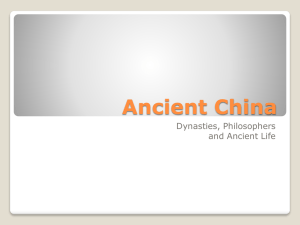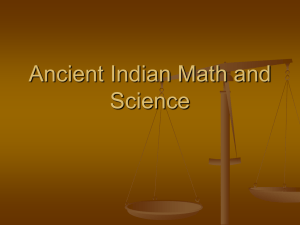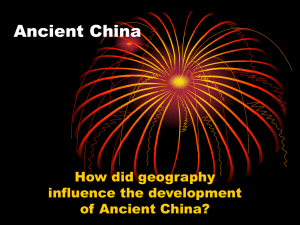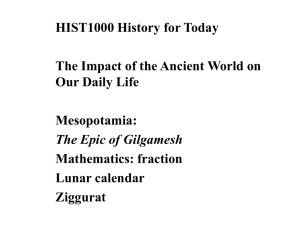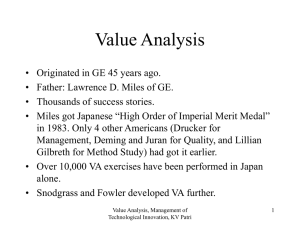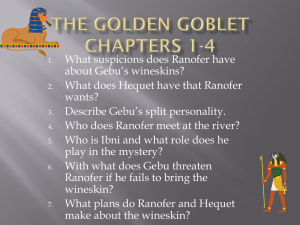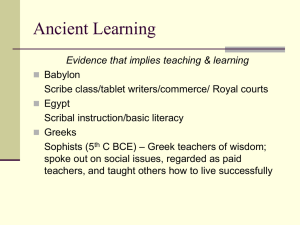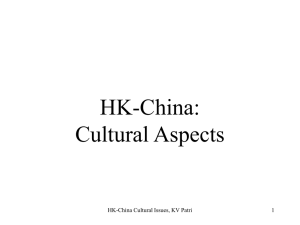Science and Technology in Ancient China - Personal
advertisement
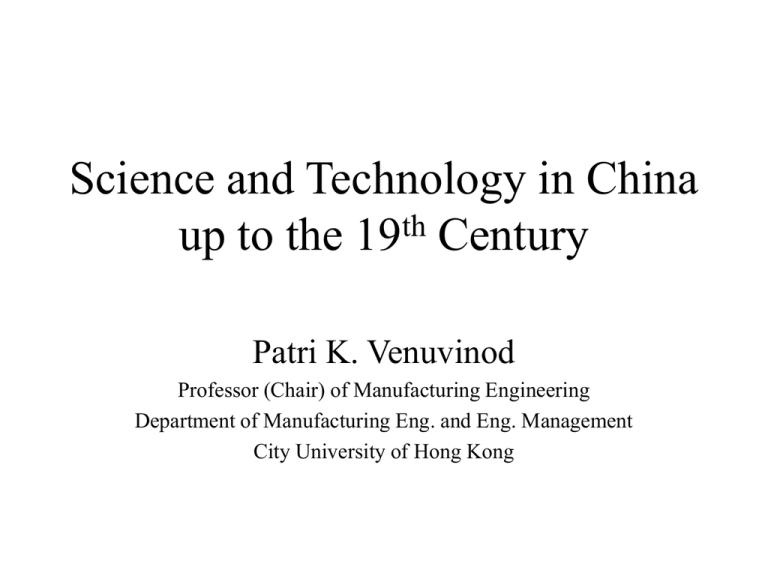
Science and Technology in China up to the 19th Century Patri K. Venuvinod Professor (Chair) of Manufacturing Engineering Department of Manufacturing Eng. and Eng. Management City University of Hong Kong Some classical Western views about China • Jonas Hanway: “the most effeminate people on earth.” • Goethe and Lord Shaftesbury: Greek and Roman empires had more to teach than ancient China. • The hero in Defoe’s The Further Adventures of Robinson Crusoe (1719): “contemptible herd or crowd of ignorant and sordid slaves, subjected to a government qualified only to rule such people.” S&T in Ancient China, KV Patri 2 But, until the Renaissance, the West barely equaled the Chinese in S&T China Civil Service Tang era, examinations A.D. 618-906 Paper T’sai Lun, Han era, A.D. 105 Molded 11th century clay types S&T in Ancient China, KV Patri The West 19th century 1000 years later Gutenberg, Germany, A.D. 1450 3 Sun spots discovered 28 B.C. Inoculation Sung Dynasty against (A.D. 960-1279). smallpox A.D. 7 Edward Jenner, England, the second half of 18th century First census A.D. 2 Steel production S&T in Ancient China, KV Patri ~150 B.C. by heating and working together irons with different carbon components ~550 A.D., the first description of open hearth process (the ancestor of SiemensMartin process) 4 Some Chinese Firsts in the World • First treatise on trigonometry (221 B.C.) • Publication of the first news paper, the so-called Beijing Gazette in the reign of Tang (618-907) emperor Ming Huang. • Oldest mechanism for astronomical studies providing continuous rotation (~8th century). • First printing of paper money (Tang: 618-907). • Gunpowder, already being used in firecrackers, was first tried out in warfare in 1161. The Mongols learned from the Chinese and used it against Hungarians in 1241. • Using calculating rods to solve equations with several unknown quantities (~13th century). S&T in Ancient China, KV Patri 5 Chronology ~500,000B.C. ~25,000B.C. 5000-3000 3000-2700 2700-2200 2205-180 1783-1134 1134-356 770-221 246-206 206B.C.-220. ‘Peking Man’ Cave man Yangshao culture 3 Emperors 5 Kings Xia Shang Xi Zhu Dong Zhu Qin Han 220-265 265-316 3 Kingdoms Xi Jin S&T in Ancient China, KV Patri 317-420 Dong Jin 420-589 Nan Bei 581-618 Sui 618-907 Tang 907-960 5 dynasties 960-1126 Bei Song 1127-1279 Nan Song 1279-1368 Yuan 1368-1644 Ming 1644-1911 Qing 1911-1949 Kuomintong, etc. 1949-present P.R.C. 6 Artisans at work A late Qing representation Caption says: ‘Preparations for all eventualities will avert misfortune.’ S&T in Ancient China, KV Patri 7 Paper-block print icon of the patron saint of artisans and engineers. In black on yellow paper, with decorative bands of color in pink, green, mauve and red. Like other tutelary deities, Kungshu Phan is enthroned as a magistrate or governor. The inscription at the top says, ‘Master Kungshu of Lu, our teacher from of old.’ S&T in Ancient China, KV Patri 8 Shang Period (1783-1134) • Agriculture, hunting, animal husbandry. • A writing system as evident from engraved inscriptions on tortoise shells. • Bronze metallurgy of highest workmanship. • King was the head of the ancestor- and spiritworship cult. • Royal personages were buried with articles of value, presumably for use in the afterlife. Hundreds of commoners, who may have been slaves, were buried alive with the royal corpse. S&T in Ancient China, KV Patri 9 Shang Bronzes, etc. • Found at excavations at An-Yang, Honan, etc.: Weapons, vessels for worship, chariot fittings, harnesses. • Complex and refined decorations with repeated motifs of animals (first time), family coats of arms, etc. • Varying proportions of copper and tin (5 to 30%) with 2 to 3% lead according to needed properties. • Chariots similar to those in western parts of Asia (Anatolia and Syria had domesticated horses and used chariots around 1700B.C.). S&T in Ancient China, KV Patri 10 Different types of Vessels connected with worship Shang (or Yin) Dynasty (1384-1025) [Gernet 1982, p.43] S&T in Ancient China, KV Patri 11 Ritual implements Shang (or Yin) Dynasty (1384-1025) [Gernet 1982, p.48] S&T in Ancient China, KV Patri 12 Dept. of Collection, Processing, Storage and Distribution of Raw and Semi-finished Materials. Dept. of Manufacture of Finished Products Dept. of Establishment of Standards for Quality, Productivity, etc. Dept. of Storage and Distribution of Finished Products Dept. of Inspection, Testing and Administration of Standards Western Zhou (11th to 8th century B.C.) According to the Records of Etiquette of the Zhou dynasty, there existed a system consisting of five departments to control the production of handicrafts in state organizations. [Juran 1990] S&T in Ancient China, KV Patri 13 ~Qin and Han (200B.C. to 300A.D.) • Invention of the wheelbarrow. • The central plain and parts of Szechuan: continuously cultivated. • Skilled husbandry: use of manure, distinctions between different types of soils, attention to the date of ploughing and sowing, drying out of marshy regions, drainage of salty terrains. Several recorded hydraulic engineers. S&T in Ancient China, KV Patri 14 • First great increase in population. • First census known to history in 2 A.D.: 57,671,400 taxable individuals. • Lack of copper and tin caused a shift to cast iron. • Cast iron axes, spades, knives, swords,… • Cast iron is more breakable and takes on a sharper edge than bronze. • Forging of steel. • China had a lead of several centuries over the West in terms of iron and steel technologies. S&T in Ancient China, KV Patri 15 • Double-action piston bellows appeared in the Han period. The device uses valves to obtain continuous current of air. • Palace economy with its bodies of craftsmen controlled by palace nobles. • State monopoly of iron and salt industries in 117 B.C. • Mass production using the same cast iron mold. Molds with up to 3 identical cavities. • Development of modern industry akin to the factory system that appeared in Europe only at the beginning of the industrial revolution. Some workshops had thousands of workers. S&T in Ancient China, KV Patri 16 • Carts redesigned. 1 shaft to 2 shafts. Neck yoke to breast yoke. Thus one horse could replace 2 to 4 horses. • Measures of length and capacity, and gage of cartwheels unified (standardization). • First ever fixing of spokes at a slight outward angle. • New class of merchant entrepreneurs (private enterprise) using fleets of riverboats and large number of carts. Economy grew beyond palace economy. • Trade with Manchuria, northern India, etc. The silks of ‘Ch’in (Qin)’ led to the name C’ina (the land of silk). S&T in Ancient China, KV Patri 17 Economic and industrial centers under the first Han dynasty (200 B.C. to 9 A.D.) S&T in Ancient China, KV Patri 18 Han Terracota Warriors: 3000 figures excavated in Shansi. S&T in Ancient China, KV Patri 19 Geared waterpower mill Jin Dynasty (265-420) [ACTS 1983] S&T in Ancient China, KV Patri 20 A military map of Qangsha area Unearthed from a tomb of Early Han period. The locations of the rivers Roughly coincide with those on modern maps. [ACTS 1983] S&T in Ancient China, KV Patri 21 Diagram of a chariot from the site of An-yang (end of 2nd millenium B.C.) [Gernet 1982, p.68] S&T in Ancient China, KV Patri 22 Diagram of a chariot from the site of Hui-hsien (Honan province) (5th century B.C.) [Gernet 1982, p.68] S&T in Ancient China, KV Patri 23 Cast-iron hoes, ploughshare, sickles, axe, and knife from the fourth-third centuries B.C. [Gernet 1982, p.71] S&T in Ancient China, KV Patri 24 Calipers made in 9 A.D. They are graduated in ts’un (tenth part of a ch’ih) and in fen (tenths of a ts’un). The face shown on the right side bears the inscription” ‘Made on kuei-yu day, on the new moon of the fifth month, first year of Shih-chien-kuo’ [Gernet 1982, p.110] S&T in Ancient China, KV Patri 25 Pre-Tang and Tang Periods • Aristocracy. • Maturing of administration and codification of regulations. • Wet rice-growing. Early ripening varieties. Chain with paddles o lift water. • New commercial routes for trading tea and salt, and supplying food to armies in the north. • New commercial techniques: the negotiable certificate, and the banknote. • Reproduction of texts and drawings by wood engraving led to sudden diffusion of knowledge. S&T in Ancient China, KV Patri 26 Calculation of =355/113 As written in Sui Shu (History of the Sui Dynasty) by Zu Qonzi (430-510) [ACTS 1983] S&T in Ancient China, KV Patri 27 Diamond Sutra: The earliest printed literature in existence. Bearing the date of the 9th year of the reign of Xian tong (968), Tang Dynasty [ACTS 1983] S&T in Ancient China, KV Patri 28 ~Song Period (~900-1300) • • • • • • • • Sundial and water clock. One year has 365 385/1539 days. First ever printing of paper money [Callis 1959, p. 91]. Chinese renaissance. Growth in military technologies. Soldiers selected through running, jumping, … tests. Tallest chosen for crack units. Troops equipped with incendiary weapons, catapults, … multiplied. Invention of ballistae, repeating crossbows, a sort of tank. Development o a substantial navy from 1127. Boats with paddles (first references ~800) actuated by a crank or by a system of connecting rods. The fist paddle boats were used in Europe only in 1543. S&T in Ancient China, KV Patri 29 • First mention of gunpowder (coal, saltpeter and sulfur) in China in 1044 (in 1287, by Roger bacon in Europe). • Daoist alchemists discovered it. • Initially used for ‘flying fire’. Later exploited the burst capacity. Propellant in a guided tube. • Fists discovery of principle of rocket using thick bamboo. • Iron or bronze tubes around 1280. • New society. A class living on unearned income. Urban bourgeoisie with land income. • Growth in food production. New varieties of grain imported and adapted from Champa (Vietnam), etc. • Expansion of manufacture. Growth in mining (iron, copper, lead, tin) • Pit coal replaced by charcoal. Hydraulic machinery to drive bellows. Use of explosives in mining. • Cast iron production in China exceeded 114,000 tonnes in 1078. It reached only 68,000 tonnes in England in 1788. S&T in Ancient China, KV Patri 30 • Ceramics: Kilns all over. • Regional specialization: Southern Hopei for iron; Szechwan for paper; Hangzhou for printed books, … • Gradual development of printing. Paper had become an ordinary material by the end of Han age. “Use of stelae bearing texts or drawings as stamps of blocks (with a coat of damp paper, drying, inking, and reproduction on paper with the help of a pad) [Gernet 1982, p. 333]” enabled cheap and faithful reproductions.Seals made possible impressions of written characters, drawings, or religious pictures. • The first important document reproduced by wood-block printing was the ‘Diamond Sutra’ dated 868. S&T in Ancient China, KV Patri 31 • First movable types in 1086. • 1313: The first turning case with characters classified in rhymes. • 1403: 100,000 Chinese characters cast. • ~1600: blocks with up to five colors. • Great progress in Chinese cartography, treatises on natural sciences (on mushrooms, bamboos, chrysanthemums, peonies, fruit-trees, birds). • 1027: Vehicle for measuring distance traveled by road. • 1090: Astronomical machine actuated by an escapement system and by cogs and transmission chains. • ~1100: Astronomical machine worked by a wheel turned by successive filling of pivoting cups fed by a tanks with a constant level. S&T in Ancient China, KV Patri 32 The water-driven astronomical clock tower As shown in the book, Xin Yi Xiang Fu Yao (New Design for an Armillary Clock), written by Su Song (1020-1101) [ACTS 1983] S&T in Ancient China, KV Patri 33 Printed text of the Sung period The first page of the first chapter of the geography of China and foreign countries completed in 979 A.D. [Gernet 1982, p.334] S&T in Ancient China, KV Patri 34 Astronomical chart of the south-polar projection of the sky by Hsin-I-hsiang Fa-yao (1092, Western Hsia) [Gernet 1982, p.340] S&T in Ancient China, KV Patri 35 Sung and Yitan Mathematics: Notation for equation +2x3+15x2+166x1-4460=0 as given by Li Yeh (or Li Chih) 1192-1279 [Gernet 1982, p.381] S&T in Ancient China, KV Patri 36 Pascal’s triangle (around 1640) as given in An algebraic treatise by Chu Shi-chieh (1303) [Gernet 1982, p.381] S&T in Ancient China, KV Patri 37 Illustration of horizontal-wheel hydraulic bellows in Wang Zhen Nong Shu (Agricultural Treatise of Wang Zhen), a book of the Yuan Dynasty (1271-1368). [ACTS 1983] S&T in Ancient China, KV Patri 38 Ming period (1368-1644) • Fashion for academic discussions. • Multiplicity of centers with libraries.Revival of interest in [practical knowledge: agronomy, military techniques, hydraulics, astronomy, mathematics, … • The first classification of 33,179 Chinese characters under 214 radicals.Translations of Western mathematical and scientific works. S&T in Ancient China, KV Patri 39 Ming Technology (1368-1582) A sowing machine, Picture taken from the T’ien-kung k’ai-wu (1637) [Gernet 1982, p.443] S&T in Ancient China, KV Patri 40 Ming Technology (1368-1582) A Mill, Picture taken from the T’ien-kung k’ai-wu (1637) [Gernet 1982, p.443] S&T in Ancient China, KV Patri 41 Ming Technology (1368-1582) A machine for reeling off thread, Picture taken from the T’ien-kung k’ai-wu (1637) [Gernet 1982, p.443] S&T in Ancient China, KV Patri 42 Ming Technology (1368-1582) A pottery workshop, Picture taken from the T’ien-kung k’ai-wu (1637) [Gernet 1982, p.443] S&T in Ancient China, KV Patri 43 Qing period (1644-1911) • Manchu, “The enlightened despots.” • The most extensive empire in the world. • High watermark of agricultural techniques. Much superior to agriculture in Europe. New crops: sweet potato, the ground nut, sorghum, vegetables, fruit (apart from the traditional wheat, barley, millet, and rice). Fish farming. Industrial crops (cotton, tea, sugar cane) too. • China’s population growth outpaced that of Europe. S&T in Ancient China, KV Patri 44 Qing continued (2) • Craftsmanship on an ‘industrial’ scale. • 200,000 textile industry workers in to the southwest of Shanghai alone. • Tea production rose from 2.6 million pounds in 1762 to 23.3 million by the end of 18th century. Supply to East India Co. from Guangzhou area. • Export of porcelain objects to the world. • Criticism of absolutism. The return of the concrete. S&T in Ancient China, KV Patri 45 Einstein argued Perhaps we should try to think why something as unlikely and odd as science has ever occurred anywhere ever, rather than why something as seemingly obvious (to us moderns) as science didn’t occur elsewhere. S&T in Ancient China, KV Patri 46 Why China missed out on domestic industrial revolution Basically cultural reasons: • Ideological orthodoxy. • Stress on conformity and tradition. • Interest in status quo of the dominant and educated classes. • Suppression of scientific invention by force (as during the Inquisition in the West.) S&T in Ancient China, KV Patri 47 • Keeping the study of astronomy, botany, engineering, and mathematics out of the schools. • The ‘tyranny of language’: ideographs do not lend themselves to abstract “theoretical” thinking. • Lack of encouragement to develop laborsaving technologies owing to tremendous pre-industrial population growth. S&T in Ancient China, KV Patri 48 Needham’s Thesis [http://www.ucl.ac.uk/sts/gregory/325/handouts/h08_chi.doc] • “The main reasons are to do with the nature of Chinese society, in particular the stultifying nature of the Chinese feudal bureaucracy in contrast to the rising capitalist democracies of the West, and the narrow and secretive master/ apprentice relations in all areas of Chinese learning.” • ”The notion of physical law is clearly important. It may be that the West derived this notion from Christian theology (the lawgiving God) which is absent in China, or that it came via Greek notions in geometry applied to the world in the Renaissance (Galileo; ‘The book of nature is written in the language of geometry’). Chinese mathematics was more arithmetic than geometrical.” S&T in Ancient China, KV Patri 49 Needham thesis 2 • “Within the Western tradition, it is easier to distinguish between moral and physical law; this is not so in Chinese cosmology, where everything has a place where it ought to be (but might not be). In the West there has been a tradition of analytical and causal thinking. We attempt to isolate those elements we believe important, and then think in a scheme of cause and effect. The mechanical world view is very conducive to this sort of thought, as is the related motion of reductive explanation. However, the Chinese tradition is one of thinking in terms of organic wholes where each part is interrelated with each other and each part has a place within the whole. Correlative and sympathetic modes of thought, where the key notions are of principles and associations linked sympathetically rather than causally are the central ideas in this view. S&T in Ancient China, KV Patri 50 Some Historic Persons c. 300 B.C. 372-289 551-479 1165?-1267 1866-1925 1887-1975 1893-1976 1905-1997 S&T in Ancient China, KV Patri Lao Tzu Meng Tzu (Mencius) Kong Qiu (Confucius) Genghis Khan Sun Yat-sen Chiang Kai-shek Mao Zedong Deng Xiaoping 51 References [ACTS 1983] Ancient China’s Technology and Science, Institute of the History of Natural Sciences, Chinese Academy of Sciences, Foreign Language Press, Beijing, 1983. [Callis 1959] Helmut G. Callis, China: Confucian and Communist, Henry Holt and Co., New York, 1959. [Gernet 1982] Jacques Gernet, A History of Chinese Civilization, translated from French into English by J.R. Foster, Cambridge University Press, Cambridge, U.K., 1982. [Juran 1990] J. M. Juran, “China’s Ancient History of Managing for Quality, Part 1,” Quality Progress, p. 32, July 1990. www.ucl.ac.uk/sts/gregory/325/handouts/h08_chi.doc S&T in Ancient China, KV Patri 52
